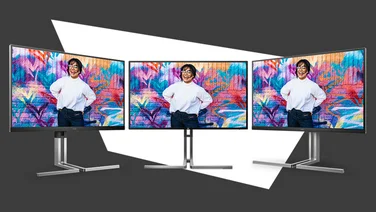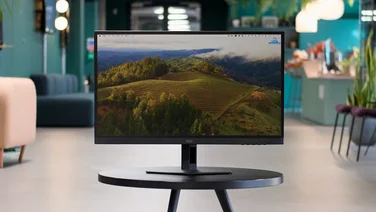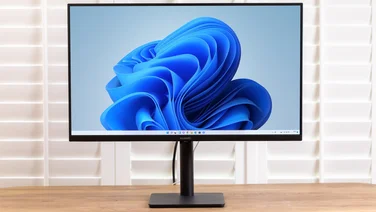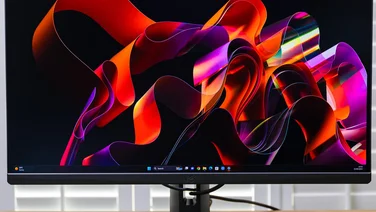To help us provide you with free impartial advice, we may earn a commission if you buy through links on our site. Learn more

- Responsive panel
- Features Nvidia's G-Sync module
- Aesthetically pleasing
- Limited to 60Hz
- Chunky stand
- Expensive
We were blown away by Acer’s XB270HU – a 2,560 x 1,440, G-Sync-enabled 144Hz gaming monitor – so I was excited to see the XB271HK. This 27in IPS G-Sync screen has a lower 60Hz refresh rate but, by way of compensation, a huge 3,840 x 2,160 resolution. It’s similar to the Asus PG27AQ in terms of capabilities but is cheaper.
Acer Predator XB271HK review: Build quality and design
Large Predator branding and a stand which is all two-tone red and black and sharp angles make this unashamedly a gaming monitor. On balance, I like the design; the stand is rock-solid for little screen wobble, and the screen is easy to adjust for height, tilt and rotate from left to right and from landscape to portrait.
The stand may be stable, but it’s also a substantial 445mm wide and 235mm deep, so make sure your desk has enough space. I like the tiny bezels on the left, right and top of the screen, which would make it easy to have a near-seamless desktop with two of these screens side by side (if you were feeling rich). There are HDMI and DisplayPort inputs, a headphone output and a USB3 hub with two ports on the bottom of the monitor and two on the left.

Five buttons on the bottom-right edge bring up the on-screen menus. As with almost every monitor I’ve seen, these are tricky to navigate until you get used to the control system’s idiosyncrasies. The options are, at least, arranged in logical categories. You can select from Acer’s Movie, Graphics and Eco presets, or tweak colours, contrast and brightness yourself. There are some special functions such as Dark Boost, which lightens darker areas to give you the edge in gloomy games at the expense of contrast. You can also reduce the amount of blue light the monitor gives off, to avoid disrupting your sleep patterns. I found knocking the blue light down to 50% made the monitor more pleasant to use when working.
There are some gamer-specific functions as well. There are three ‘game mode’ presets, where you can save custom monitor settings to recall at the touch of a button, but I’m not sure how these differ from standard monitor presets. You can also turn on a gunsight in the middle of the screen for those pesky games that don’t give you a sight when shooting from the hip, but this feels old-school and I found it spoiled immersion.
The screen has a pixel overdrive (OD) function, which is designed to reduce ghosting, where the pixels cannot keep up with the action onscreen so leading to blurred images. However, ghosting is more of a problem at refresh rates higher than 60Hz, and I didn’t see much improvement using the tests at testufo.com/ghosting. Setting the OD to Extreme also added significant artefacts to the image.
Acer Predator XB271HK review: G-Sync
G-Sync, however, is a joy. This is designed to sync the frame output rate of your Nvidia graphics card with the refresh rate of your monitor, to avoid tearing (when the graphics card outputs more frames per second than the screen can display) and stutter (when the graphics card lags behind, so the screen has to show the same frame more than once).
I find G-Sync is at its most impressive when a game is running at less than the standard refresh rate of the monitor, when it can make frame rates around 35fps look far smoother. This monitor’s 4K resolution is a challenge for any graphics card, so G-Sync is particularly useful. In Dirt Rally, running at 3,840 x 2,160 with Ultra detail and G-Sync off, I saw a regular 35-40fps and significant stuttering, but with G-Sync turned on the game was perfectly smooth: even once I turned down the detail and turned on V-Sync to lock the game to 60fps, I could barely tell the difference between the lower and higher frame rates.
Acer Predator XB271HK review: Picture quality
The screen acquitted itself well in our image quality tests. Before calibration, it was covering 100% of the sRGB colour gamut with a low Delta E colour deviation of 0.54. Results after calibration were similar, but the calibration program brought the screen much closer to the ideal colour temperature of 6500K, with 6539K compared to 6727 pre-calibration. Image quality is still great out of the box, with a high contrast ratio of 1018:1 helping our test photos shine.
There was one significant problem, and that was visible backlight bleed at the bottom-left of the screen. This was confirmed by our colour calibrator: in the middle of the screen it recorded a black level of 0.272cd/m2, but at the bottom-left this rose to 0.555cd/m2, which in turn reduced the contrast ratio to 401:1. It’s a shame, but I doubt it will have much impact on the user.
Acer Predator XB271HK review: Verdict
The Acer Predator XB271HK is an excellent 4K gaming monitor, and it should be on the shortlist of anyone with a powerful Nvidia graphics card who fancies a bit of stutter-free 4K gaming. Those into twitchy shooters may find the 60Hz refresh rate isn’t enough, however, so should consider the 144Hz XB270HU instead.








